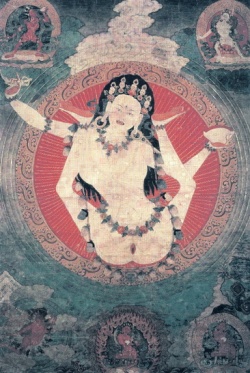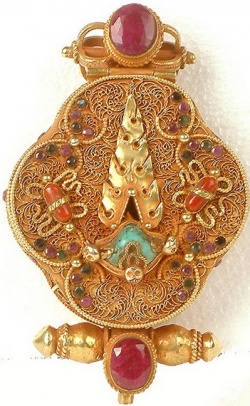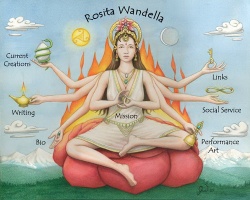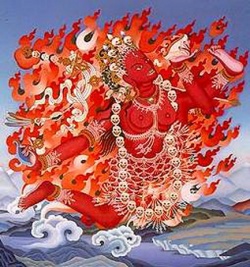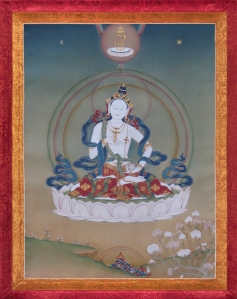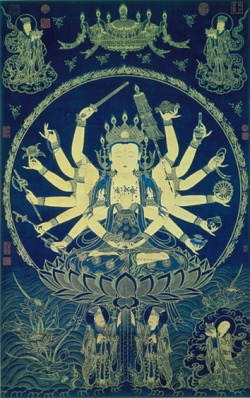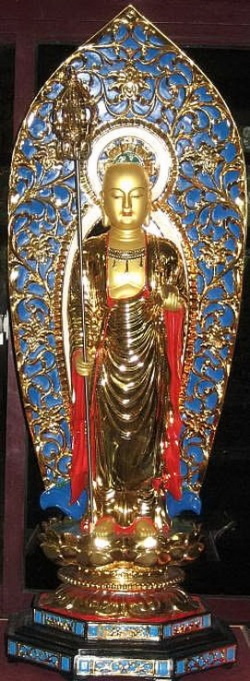Empowering the wise woman
Green Tara is a Tibetan meditation deity. She's a goddess who teaches us through having us meditate on her. That way we viscerally integrate her teachings in our experience. When we imagine ourselves as Tara, we practise what it feels like to be enlightened.
Tara is the goddess of compassionate skillful action, and protects us from fears. She has one leg drawn back in meditation posture; the other is forward a bit, so she can leap up and help when she's needed. She shows us how to live the deep insight of meditation, and apply that in action in the world. A good role model for mothers!
Tara comes to us from an ancient, unbroken, living tradition of practice. We've developed a special way of working with traditional practices. It's essence work, using simple images drawn from the more detailed classic images and texts. These transcripts come from guided meditations working with groups, dakini circles. Each text works with a single theme, out of the huge
range of approaches and possibilities for practising with Tara. We concentrate especially on the bodily experience of Tara – what it feels like. The texts are not meant to be exhaustive. They're not the only way to practise. They're designed to set you off in fruitful directions.
Tara teaches us on many levels, how to live in the world as an enlightened wise person. We'll briefly lay out some of the range of what she teaches.
===COMPASSION===
Wisdom and compassion are the two qualities of enlightenment, the two wings we fly with to enlightenment. They turn out to be interwoven.
We usually start our work with compassion. It's more personal, more accessible. With Tara, we practise what it's like to be a compassionate wise woman.
As part of compassion work, we also work with our emotional difficulties and traumas. Then we can understand the deep wisdom teachings more clearly. Emotional and psychological healing is an important part of moving towards enlightenment. As long as we are in emotional confusion and distress, we don't have the calm and openness to see clearly the nature of mind.
Tara is so skillful that she works with our emotional healing, while also constantly by her nature, reminding us that emotional healing is to liberate us from suffering, through full awakening. When we become her, we become the wise woman within, who knows how to be in the world with an awakened mind. We release our confusion and fears, so the wise woman can shine forth.
Tara protects against fears. That has many levels from psychological healing to overcoming our sense of separateness in the world.
What sort of fears are we talking about? ultimately, any emotional disturbance is a fear. It causes us to be tied up in emotional patterns that separate us from the world.
Traditionally, Tara works with eight fears:
- loss and gain
- praise and blame
- notoriety and fame
another way the fears are described is:
- fear of
Both these lists can be found in the outer world; it's also easy to see how they represent our inner emotional turmoils. We explore many ways of working with all this through Tara.
One way is to understand Buddhist teachings on overcoming suffering, by understanding impermanence, and how greed, hatred and ignorance cause us suffering, by the way we cling to having this and not having that.
Through our relationship with Tara in meditation we deal with fears also in more visceral intimate ways. We can work with her as a companion, or become her ourself.
When we meditate on her in front of us, separate from ourself, she's our companion. We develop a relationship with her. It's a practice ground for how we relate to ourself and to others.
Tara's an enlightened goddess who can see our wisdom and goodness, even when we cannot – and love us, despite our confusions. For me, this work has been like re-mothering. The wounds of childhood come largely from imperfect parenting. I imagined Tara as like a 'perfect mother', and spent years practising how to relate to her, how to feel her as loving, protecting and all the qualities I needed, to heal childhood lacks.
Re-mothering can seem like working on an emotional and psychological level only. However it's the way we develop compassion. Re-mothering is learning to love and be loved, which we have so many lacks around in our Western culture. We build a healthy self, through seeing the light in Tara's eye for us.
Sometimes I thought, this is idiotic – I'm just imagining it. However, imagination can be a place we can explore, experiment, and let our creative powers take us to new discoveries. In meditation, it can help us deeply integrate and embody healthy states of being. We take 'imagining' to a deeply visceral level.
When we are ourself the body of Tara, we use the green light, of which her body is made, to let the feeling of compassion grow in our own flesh. This helps us develop a sensitive awareness of what's happening in our body. Emotional traumas stored in the body can be compassionately rought to awareness, and this in itself heals them. We can also use variations on the 'clearance' methods developed by Namgyal, my teacher. (explained elsewhere)
When we've learnt how to experience Tara's love towards us, and we're full to the brim, we then beam it out to all other beings. This helps us see how interconnected we all are, and that increases our compassion.
===WISDOM===
Wisdom gained in meditation is not so much an intellectual knowing; it's a whole-body-presence knowing. It opens up through many steps. The first is to understand we are not the thralls of our thoughts. Gradually through learning to rest in the present moment, we experience in a whole new way what it is to be a 'self' in a body, a form in union with void. In the next few sections we explore how Tara helps us embody this wisdom, by meditating that our own body is the wise body of Tara.
===CALM AND PEACE===
This is the first lesson of Tara the meditator. The first thing we look for in meditation is calm. It's also the first step in wisdom: to go beyond the net of thoughts and anxieties, that we're mostly caught in. Then we can see more clearly.
Tara help us understand the power of peace. The peace and calm we achieve in meditation is not a blanked out state. It's a beautiful delightful, powerful, being present in the present moment, able to respond to anything that is needed.
===PRESENT IN THE PRESENT MOMENT===
This is the heart of meditation practice. The present moment is called Mother of all Buddhas. It's the only place we can awaken. It can seem strange to visualise the complicated figure of a goddess, to bring ourself into the present moment. It works though. There's no other place we can visualise ourself as Tara but in the present. We become a peaceful awakened goddess, resting in the present moment.
===VOID AND THE GREAT MOTHER===
Tara's green body of light, that arises out of emptiness, or spaciousness, is direct teaching on what it feels like to live in the lap, or embrace, of the Great Mother, and explore what the Great Mother herself feels like,
This is the heart Buddhist teaching: 'form is void, void is form.' Form and void are the same, not two separate states. Void or emptiness are the commonest Buddhist terms used. They can feel impersonal, often frightening. For women they can feel neutral, in a way that makes us feel we must set aside our femaleness, to experience it.
Often in Buddhism, void is called Great Mother. For people who are open to the idea of working with the Great Mother, it's proved an easy way to access the feeling of what 'emptiness' really is. It's not empty – it's a state of primordial loving awareness.
===WHAT KIND OF SELF DO WE GROW INTO?===
We often hear Buddhists talk about the death of ego. This is not the death of a sense of self. It's letting go fears, worries and anxieties about how I want to be, and how I don't want to be. It's a complete change of how we understand what our 'self' is.
Tara as an enlightened goddess obviously has a strong presence, as some kind of self. She hasn't evaporated by being enlightened. She's become more empowered, even more capable of acting with compassionate skillful means. She's an empowered resilient 'self', who can be fully present in the world, while at the same time knowing she's also emptiness – that's felt through her body of green light.
She also knows she's totally connected with all beings. Meditating on her, we get to explore what it feels like to live in a different kind of self.
===SENSUALISATION METHOD===
A word about the methods of visualisation. First, this is not only about visualising with the sense of sight. We use all our inner senses to create the image – kinesthetic, touch, sound, smell. A better word for this is sensualisation.
All our life experience comes through our senses. Tara shows us our creative mind, how we create our world. The way she arises out of Great Mother spaciousness, and dissolves back into that, shows us how our thoughts and perceptions constantly arise and pass away. They're impermanent - and impermanence is not scary. It's creative. Tara shows us how we can use this creative mind to lead us to wisdom.
The method sends a dream image to the depth for it to grow around. When we dream, our depth sends up an image to our conscious mind, as part of its healing process. When we create the image of Tara, we send this healing image to our depth, like a reverse dream. We create a relationship with our own depth, commonly called the 'subconscious,' which assists the process of healing.
===EMPOWERING THE WISE WOMAN===
Both men and women practise Tara. In addition, Tara serves a special purpose for women. Long ago, she vowed always to be reborn as a woman, to show women it's possible to awaken in a woman's body.
Even in our modern age, women still suffer from internalised oppression, which can make us feel unworthy and inadequate. Tara is a role model, for what wisdom can be like in a woman's body. This can be very enriching and empowering work for women.
===TARA THE ENVIROMENTALIST===
One title of Tara is Khadiravani: of the forest. I believe she may originally have been an ancient nature deity. Her compassion extends to trees, animals and all creatures as well as humans. She's an environmentalist.
===CULTURE SHIFT===
A further dimension of work with Tara, is that she embodies an entire paradigm shift, a culture shift in how we understand what life is for, what values bring us happiness, how to live and work with our interconnection with all creatures.
Her practice is part of an ancient tradition called tantra, which means a thread in woven cloth. It's about how to live as part of the weave of the world - without being entangled in the nets and traps of believing it to be permanent and solid.
This life-affirming path teaches us not to withdraw from the world to find our spirituality, but to experience 'ordinary' daily life as full of the magic and mystery of spirit.
This is what Riane Eisler calls the Partnership paradigm. It's the same as the one developed by western goddess spirituality and ecofeminism.
These teachings of how to live as part of the weave of the world can be applied on an inner personal level, to live in the world in a liberated way. We can also apply it to our relationships, with the people around us and the nature. it can also be the basis of a clear vision of what we need, to create a lasting sustainable way of life on this planet, for all of us.
This may seem very large. Can Tara save the world? Yes indeed. To take on a big task like saving the world, we need a clear vision, to keep us going. We also need the almighty compassion of Tara. And we need the personal empowerment and support she brings us.
H.H. The Dalai Lama has been calling women to come forward and save the world. He says women, because we are mothers, have deeper compassion and sensitivity to suffering, and are better geared to find peaceful ways to dialogue, rather than trying to use war to solve problems. Yes, with Tara as companion and guide, we can save the world – as well as ourselves.
==Green Tara ==
Green Tara is the embodiment of All-accomplishing Wisdom. She has one foot in worldly activity, the other in the profound peace of meditation. She protects against fears of all kinds.
Green TaraHow can we be smiling and relaxed, and at the same time swift acting? What would life be like if we were enlightened? in touch with our depth wisdom?
Tara is a model for women of how we can develop the power of peace, and compassionate skilful action. We already have the wisdom within us. Tara helps us bring it forth. She helps us care for ourself and others. and helps us live in our goodness, not swayed by the eight fears.
Green Tara applies her wisdom to daily life. She offers us a chance to learn how to mediate on the Goddess, in an ancient living tradition of practice.
- Dancing Wisdom Dakinis or skydancers.
- These are Buddhist archetypes for strengthening and enlivening the self.
The dakinis, or skydancers, help us explore who we are. No more low self-esteem! Dakinis build a full-power, empowered self, who dances through life. We’re not a fixed static self, we’re the dance of elemental forces in space.
Dakinis show us our beauty, joy and wildness; how to be the power of compassion so we meet suffering with love; be the power of our suffering so we can transform it into wisdom. They show us a self who can laugh and growl, embrace both terrible and wonderful sides of life; active and peaceful at once, stillness in dance
We explore the Goddess and the feminine in Buddhism; and the 'engaged Buddhist' dakini - they strengthen our bodhisattva intent, to relieve the suffering of the world as well as our own.
==21 Taras==
Climate Change presents us with difficulties and fears different from ‘business as usual.’ Many people find it too overwhelming to think about our future. Hiding our heads in the sand won’t help us tackle what needs to be done, in our personal lives or the wider world. If we face up and act quickly, we can create a sustainable way forward more happy and fulfilling for all than what we have now.
Green Tara and her sisters are ancient meditation deities, who still have much to offer us now. They help us deal with fears, then build the strengths and wisdom we need. Even the traditional names of the fears they work with fit our times: problems with earth, fire, air - war, political troubles, crime, disease, untimely death, poverty, frustration of hopes and plans.... all these are common themes in any discussion about what we may face.
Tara’s an Engaged Buddhist - a Bodhisattva: she applies Buddhist compassion and ethics to help the world. She doesn’t only sit meditating, beaming vibes at everyone. She’s in there boots and all, dirt up to the elbows, mucking in to help. This is how Engaged Buddhists are: involved, participating.
Many Buddhists think being a bodhisattva has nothing to do with ‘worldly’ things like social action. A huge amount of suffering is caused by our social systems: from human poverty to environmental troubles. Climate change and Peak Oil are already causing suffering for humans, animals and forests. Creating social change, to reduce suffering, is a big part of what we can do to help - especially at this time: ‘You can no longer save your family, tribe or nation. You can only save the whole world.’
Margaret Mead - (quoted by the Change the Dream Symposium)
It's a challenge to work in the world while remembering our moment-to-moment presence, the fluid changing state of our being. How do we immerse ourselves, hands-on, and not lose ourselves, not get embroiled and trapped, in the suffering we hope to alleviate?
The Bodhisattva path isn’t easy. It requires endless compassion towards our own lapses and confusion as well as others’; tuning into everybody's good motivation; not getting caught in activists’ squabbles.
Tara is ‘our own mind in the form of Tara’. We become Tara, to practise what it feels like being awakened. Visualising a deity is like having a conscious dream. The image works in the Depth, where dreams do their healing.
As we were all women on our retreat, we considered how a female deity helps with our conditioning and strengths as women. We practised being proud and confident, to feel the presence of this compassionate Wise Woman within. Lack of self esteem is a common and disabling problem for women. Remembering Tara within keeps us in touch with our fundamental wise compassionate Nature.
We are incarnate, in a human body: and part of our community on this planet. Tara teaches us how to be a human body in the awakened state. Buddhists sometimes say ‘oh well nothing matters, it’s all emptiness.’ Tara shows us how emptiness and form coexist: the wisdom and love of being present in the world. That’s our nature, while we’re in a body.
Tara helps us understand 'emptiness' in a bodily way. We can be fully in body and mind, in this life, while knowing in our cells that it's all love-light, like the light-body of Tara - not 'solid' reality. When we live this two-in-one truth, we’re responsive, fluid, compassionate and joyful.
Tara’s specialty is skilful action, All-Accomplishing Wisdom. We meditated on her methods of compassionate action, represented by her jewellery: generosity, patience, morality, enthusiastic perseverance, concentration. Green Tara’s concerned with all Nature: animals, plants, water and soil.
Together we asked, what kind of culture could we create, if we based it on what Tara shows us? What would sustain us in our future with Climate Change and Peak Oil? How to muck in and help in a wise way? We can create helpful external conditions; we can also help people understand how our inner confusion, greed, hatred and ignorance, create suffering and ineffectiveness within, and for others around us. Our present system of growth economics isn’t carrying us into a healthy future: it’s based on the same greed, selfishness and ignorance as our internal pain.
We need to create a ‘Great Turning’ (Joanna Macy’s term) to a new paradigm, a new system of values. What values does Tara live by? Similar to Mother Nature - life-supporting, co-operative?
Most of us at the retreat are involved in Transition Towns, which are based on the Permaculture model. Permaculture is based on Nature’s ecosystems and life-supporting values. Tara reflects these beautifully.
The 21 Taras lend themselves to deep psychological work: they bridge meditation and psychotherapy. The ‘fears’ Tara protects from include all sorts of emotional distress. The fearful one can be present within us at the same time as the wise one. How can our Wise Woman be compassionate to parts of us not yet so wise? She can hold the distressed one, as if in her arms, support her with gentleness and love, and give her the strength to work with distress. This process of transforming fears to strength is core work of Tara.
We chose three Taras who reflected issues we wanted to work with. As we developed their strengths, the emotional difficulties around that issue arose. For example, the Red Tara of Power embodies rich joyful compassion that celebrates the positive - sympathetic joy. It’s empowering to develop confidence and strength as women. With that warm compassion, ‘female wrath,’ much of it from disempowerment, transmuted into joyful love.
We used methods akin to Namgyal’s clearance work. With Tara’s compassionate awareness, we watched how wrath and other emotions were reflected in the body. That releases the energy locked up in fear and distress and transforms it to strength. Tara’s loving awareness reinforced that work. We also painted, to help the ‘dream’ process along.
Clearance work isn't just about getting emotions clear. There are profound effects. It gives us insight into our body as constantly shifting energy flows - and stucknesses.
It brings us deftly into the present moment. Kenpo Tsultrim Gyatso said to me, ‘the present moment is called the Great Mother, because it is from realising it that all awakened beings are born’. In the present moment a different space opens out. Clinging is the origin of emotional difficulty. In the present moment we’re simply present with what is: there's no chance for clinging. There’s compassion, that’s the essence of being aware.
We might think we're keeping our ‘self’ comfortably in place. Of course, it's not at all comfortable, it's profoundly disturbing and shifts the basis of our habits and ways of operating; and it creates strength and confidence, in a place beyond our isolated personal sense of ‘self’. The energy that's liberated by being present in the moment, transforms into the love-light body of Tara.
It's a beautiful trick. Relax into the Mother Moment in the midst of storms, turmoil and worry: it’s a place for us to remember, not exactly that there's something beyond worldly concerns: there's a place of rest, right there, in its midst. We can constantly go back into let-go if we get caught.
Hands-on compassionate action is mucky, complex and fun. It's fun to exercise the creative power of vision. Meditating withTara uses our creative mind; we create an image of the wise being we aspire to be. Our whole life is creative mind. Being socially involved is also a creative activity. When we create a vision of community, we create a vision of a planet of Taras - 21 zillion of them. What would that be like?
Personal fears from family patterns, and how we cope in our individual lives, are part of a wider context. Our conditioning is created not by parents, but by the social conditioning our parents and everybody else are subjected to. ‘Personal’ work is not separate to social issues and the community around us.
As times change with global warming, personal and social issues will be interwoven. If there’s suddenly no food in the supermarkets we’ll have fears for our safety - and whether our community can work together to keep us all safe.
The 21 Taras are a group of goddesses, who work together and co-operate. This provides a model for an egalitarian group method for meditation teaching and retreat. We can practise what an egalitarian social order could be like.
I facilitated the group to share in depth about our meditation experience. Everybody became a teacher for everyone else. We heard everyone's experience - common themes, the possibilities, how varied is what can happen. It can be raw, exposing work, as we get our hands dirty in our own conditioning, habitual suffering and confusion. It was important that the group all be loving Taras, and hold each other respectfully, as compassionate wise women.
Sharing the ‘emotional work’ with Tara is not only practising compassion to self and others; we experience the fluid and changing nature of ‘emotion’ - and break down barriers that separate us.
Sharing helps us reach depths with the technical process of meditating: detail about how we respond to what came up in meditation, how we work with it to open up depth and clarity, develop compassionate awareness, and get the feel of what a state of wisdom is like.
One person said she hadn’t just been given a fish: she’d been taught how to fish: tools to do her own growth process.
Tara is the goddess of compassionate skilful means; this way of working with a group is skilful means that produces great compassion, in all of us, as we hear each other's pain and joy.
I love sharing this precious work - seeing the effect of working with Tara. All made tremendous use of it. The honest sharing was held with tenderness by everybody. I marvel at the power of these goddesses, how deeply they move people along.
Three of the group wrote a short bit about their experience of the retreat. It’s in the spirit of the sharing that happened in the retreat itself.
from retreatants:
"The 21 Taras" with Dido Dunlop at the Wangapeka Retreat Centre was a life altering experience! Dido is a wonderful, compassionate teacher. The 21 Taras gave me many positive archetypes to inspire the rest of my lifetime. The Retreat Centre is so condusive to spiritual practice by it's shear beauty, life-affirming permaculture garden, splendid buildings, not to mention the near by Wangapeka River. J
The task........”your retreat experience in 200 words”......... feels like mission improbable for this long winded Sagittarian ... the threads of my entire life felt interwoven with my retreat experience....so squashing and squishing that into 200 words, for that kind ruthless pruning I need Dial a Virgo .
In a nutshell, my ten day retreat was like being inside the erupting core of Mt Vesuvio as it simultaneously endured a 7.5 magnitude earthquake.
A serious encounter with cancer a couple of years ago followed bout after bout of illness meant that virtually all the external structures in my life including my home, friendship ,work and country of residence had been dismantled,. leaving me ripe for more acute observation of the internal landscape.
Severe bouts of depression have been a feature of my life for the last 25 years, first rearing its head in London shortly after my first encounter with the Buddhist teachings. I would attempt to seek refuge, solace and meaning from within the Buddhist teachings during these descents but instead what occurred was a rift, a schism between my lived experience and the Buddhist teachings.
Instead I found meaning and understanding of my inner experience within the field of psychological astrology, a study which has also spanned 25 years.
The absolute magic and gift of this ten day retreat with Dido was that these three threads danced together in a spontaneous ,uncontrived and sustained way.
The healing of this schism was aided by a set of fortunate circumstances. I was the sole retreatant for seven days and Dido responded to this by generously allowing the retreat content to follow my process. This gentle, supportive structure, like a kind ,loving parent and the magic that is Wangapeka seemed to allow my being and my will to relax and to then spew forth what needed to be dislodged, seen and felt thick and fast.
Four months later I continue to process the richness of this experience on a daily basis and it has forever changed my relationship with the Buddhist teachings. A deep thanks to all of you that hold up and support all that is Wangapeka. C
A time of reconnecting with the wellspring, I experienced this retreat as skilful, empowering and democratic - Dido's "Teacher as Faciltator" style places each of us firmly at the centre of our own experience - nothing is discarded, excluded or avoided. The "negative emotions" were a source of transformation, energy and joy. This was my experience of the 21 Taras retreat and my time with Dido and our small group of women at the Wangapeka.
I approached the retreat as an interested, slightly detached observer. I left joyous, connected, grounded and healed- by the teachings, by the deep sharing within the group, by the magic and beauty of the surroundings, and by the ease and simplicity of each day. No harsh regimens - rather, a resonant silence in which I re-learned the power of deep listening- feeling my heart opening to others, and experienicing my energy and happiness returning.
Thank you Dido and keepers of the Wangapeka for this rare and wonderful opportunity. P
==Black Tara ==
Of the 21 Taras, Black Tara is a role model for integrating the 'Shadow'. Rather than be overwhelmed and daunted by deeply difficult emotions, we can work with them with Black Tara's powerful compassion. We can be proud Mistresses of the Dark. A determined yogini needs to have confidence that she can meet big obstructions skilfully and transform them to wisdom.
Black Tara's beauty is also part if our work. Powerful women can be gorgeous too! This isn't always obvious when in our society, if a woman shows strength, we're still in times when many find her 'threatening'.
